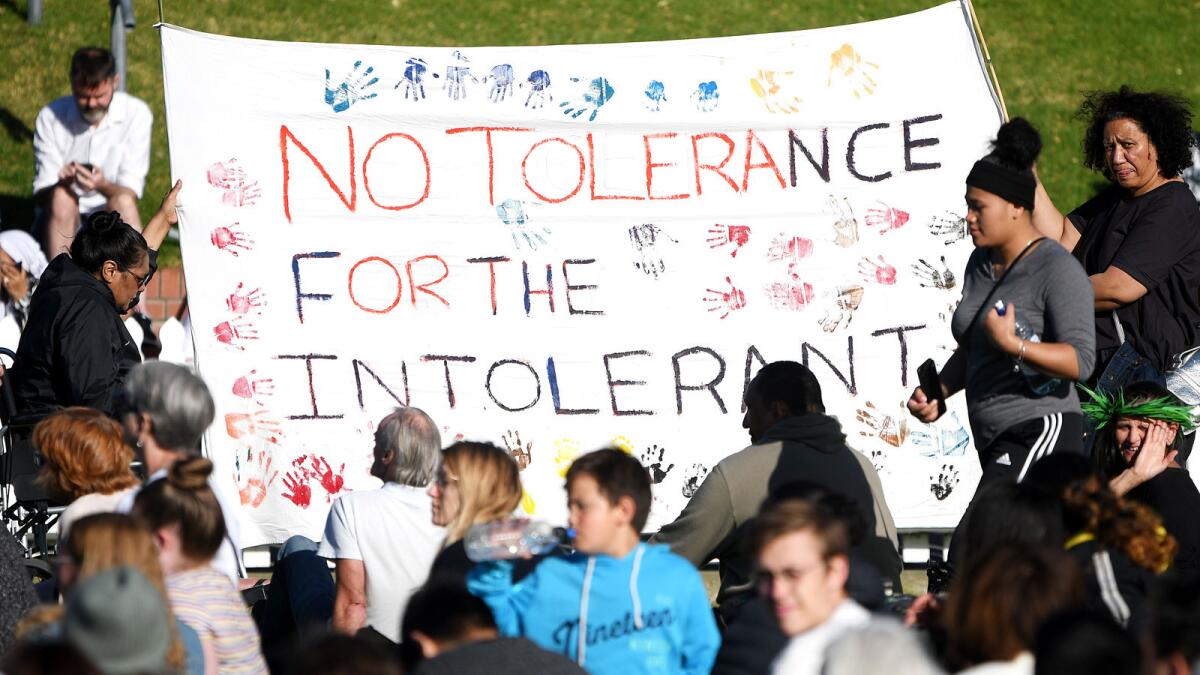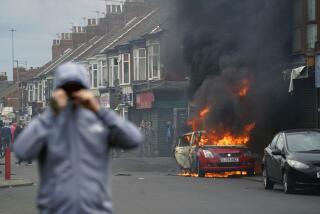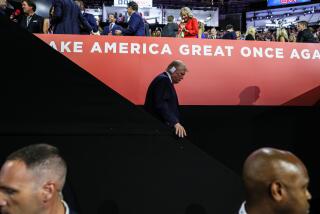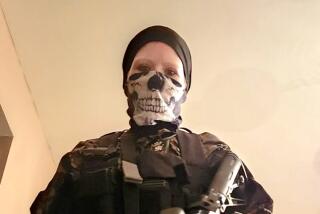White supremacism in Australia, long a virulent strain, is amplified by the Internet

Australia, the home of the suspected New Zealand mosque mass murderer, has long fostered a strain of race-based, anti-immigrant extremism.
Settled as a white British outpost in Asia, originally as a convict prison, its government adopted what became known as the White Australia Policy to restrict non-European immigration soon after the founding of the nation in 1901. It was not until nearly 75 years later that laws were passed to ban race playing a part in immigration policy — but from the 1990s immigration again became one of the nation’s most contentious issues.
John Howard, elected in 1996 and eventually the nation’s second-longest-serving prime minister, demonized asylum seekers to win one election in 2001. Ahead of a hard-fought campaign, Howard whipped up fear when a Norwegian cargo boat, Tampa, rescued hundreds of asylum seekers from a sinking Indonesian fishing boat. His government sent the survivors to detention centers on the tiny island country of Nauru, establishing Australia’s controversial offshore detention policy for asylum seekers.
Critics say the sort of dog-whistle racism that echoes in the political mainstream has also served as a tacit nod enabling even more extreme views to take root and be amplified.
“The biggest problem and technological challenge is there’s so much noise in the general political discourse with quite senior politicians, at times the prime minister and senior ministers, buying into this ‘politics of fear’ spin, that that noise makes it hard for authorities and police to see a signal from those who are transitioning from rhetoric to action,” said Greg Barton, chairman of Global Islamic Politics for Alfred Deakin Institute for Citizenship and Globalization, at Deakin University in Victoria.
These days, the message of Australia’s far-right racial extremists is spread swiftly, loudly, far and wide through the Internet — the vehicle used by Brenton Tarrant, the Australia-raised man identified as the terrorist armed with assault-style rifles and a helmet camera who randomly slaughtered 50 mosque-goers in Christchurch on Friday.
Livestreaming the massacre, after using social media to announce the coming atrocities and spread a 74-page so-called manifesto, the suspect reached out to like-minded extremists in Australia and the world beyond. In extremist chat forums, some cheered his actions.
Australian extremist groups these days include the Antipodean Resistance, the United Patriotic Front, the Southern Cross Soldiers, and the Lads Society, the latter of which tried to infiltrate the conservative Nationalist Party, part of the nation’s coalition government, in an attempt to manipulate policies.
Australian far-right extremists often call themselves NEET — not in employment, education or training — and condemn “ruthless elites” and intellectuals. Many of them blame Jews for non-white immigration.
One Melbourne-based group known as the Dingoes runs a regular two-hour podcast, “The Convict Report.” Their obsessions are the predictable stuff of white supremacism: discussion of “breeding” of whites versus other races; the WP (or women problem) with females generally despised but required for “breeding;” a hatred of Lefties (left wing liberals) and immigration and a disgust of vegans and soy eaters.
A related Melbourne group has aired white supremacist programming called “The Absolute State” from “Melbadishu” (a reference to Somali migrants), “churning out wrongthink,” advocating eugenics and restricted voting rights.
A few weeks ago, “The Convict Report” welcomed a New Zealander named Johan Wolfe, author of a blog called the Dominion Movement, for a rambling conversation punctuated with guffaws and camaraderie that seemed designed to suggest the banter of ordinary blokes propped up at a pub. The atmosphere was not fury but humorous contempt and despair about the common “problems” faced in Australia and New Zealand.
The anonymous hosts who call themselves Tory, Digger and Herschel expressed admiration for Wolfe’s website and its message: “White New Zealanders are standing up.”
On Friday, the Dominion Report distanced itself from Tarrant, claiming its ideas were peaceful, and announced the site would be closed down. But articles by Wolfe and others remain online.
Although Australia’s white supremacists share many ideas with U.S. far-right extremists, they often espouse casual anti-American sentiment. Americans are called “seppos,” which derives from a shortened form of the slang term “septic tank,” rhyming with “Yank.”
Lumped together, far-right Australian social media-makers refer to themselves as Dingo Twitter.
In “Straya,” they say in their slang, true blue cobbers all speak the lingo. Straya refers to Australia. A cobber is a loyal friend. True blue means genuine. Lingo is language.
The person identifying himself as Tarrant used the word “cobbers” in a final posting on the unregulated far-right message board 8chan just before Friday’s attack. “You are all top blokes and the best bunch of cobbers a man could ask for,” apparently referring to the virulent online community of Australian extremists from whom he found affirmation.
Well before Friday’s horrific rampage, racist attitudes have had significant real-world repercussions.
The Executive Council of Australian Jewry, which tracks extremist actions, reported that 366 anti-Semitic incidents were recorded in 2018, a 59% increase on the previous year, singling out the neo-Nazi Antipodean Resistance for more than one-third of the year’s cases.
“A tiny and peripheral group of maladjusted youths has had a disproportionate impact,” the report found. “There has been a noticeable emboldening of the far right, as has been occurring in much of the Western world.”
While the American alt right adopted the meme Pepe the frog, the touchstone for Australian white supremacist extremists is a cartoon of a sun-tanned man with toothy smile, a hooked nose, an Australian hat and a stubbie (small bottle) of VB (Victoria Bitter, a popular Victorian beer). Tarrant used the meme in his final post prior to his arrest, including a link to the Facebook feed where the attack was livestreamed.
Even in the hours following the killings, the sometimes symbiotic relationship between the far-right online community and nationalist Australian politicians remained in evidence.
Fraser Anning, an independent Queensland senator, publicized his nationalist white sentiments on parliamentary letterhead, claiming the real cause of the violence was immigration. On Saturday, Anning punched a teenager in the face after the 17-year-old struck him in the back of the head with an egg.
With an election due in May, and the government predicted to lose, the political temperature has been rising.
“Because the Liberal National Party coalition government is so desperate to try and get positive polling because they have had 50 weeks of very poor polls … they are desperate to try to get traction with this politics of fear. So there’s been a lot of panic. Desperate measures are at play again,” said Barton.
Prime Minister Scott Morrison has himself entered the fray, Barton said, calling on Muslims to “do more” to stop terrorism after a knife attack in downtown Melbourne in November last year.
“If you’re an imam or a leader in one of those communities, you need to know who those people are in your community that might be doing that,” Morrison said at the time.
One of Morrison’s favorite boasts is that he was the architect of the “Stop the Boats” policy that saw asylum seekers, including children, confined indefinitely on Manus Island, Papua New Guinea and Nauru — a policy now being wound down.
For years, other senior members of the government including Peter Dutton, who lost to Morrison last year in a bid to become prime minister, and his ally former Prime Minister Tony Abbott, have fostered fears over immigration. For example, Dutton claimed last year that people in Melbourne were terrified to dine out because of “African gangs,” and warned a few months later that “illegals” would board Indonesian boats and arrive in record numbers if the opposition were elected.
In January last year, Abbott opposed “the rate of immigration at a time of stagnant wages, clogged infrastructure, soaring house prices and, in Melbourne at least, ethnic gangs that are testing the resolve of police.”
The nation’s problematic racial attitudes have also been reflected in its handling of indigenous populations. In recent years, one state official announced plans to “close down” hundreds of small bush settlements of Aborigines. And Abbott once said that Australia Day, known as “invasion day” to indigenous people because it marked white settlement, was good for Aborigines because it brought white civilization to the nation.
Australia’s French-born former race discrimination commissioner, Tim Soutphommasane, declared last year that the mainstream political debate on crime, multiculturalism and immigration continues to fuel divisions.
“Right now, it feels like there has never been a more exciting time to be a dog-whistling politician or race-baiting commentator in Australia,” he said in a final speech before stepping down.
In the chaos of the New Zealand mosque attacks, one hero’s action saved lives »
Twitter: @RobynDixon_LAT
More to Read
Sign up for Essential California
The most important California stories and recommendations in your inbox every morning.
You may occasionally receive promotional content from the Los Angeles Times.










